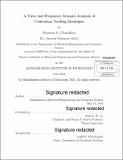A time and frequency domain analysis of contrarian trading strategies/
Author(s)
Chaudhuri, Shomesh Ernesto
DownloadFull printable version (5.010Mb)
Other Contributors
Massachusetts Institute of Technology. Department of Electrical Engineering and Computer Science.
Advisor
Andrew W. Lo.
Terms of use
Metadata
Show full item recordAbstract
This thesis applies time and frequency domain analyses to a high-frequency market making strategy to study the profitability of liquidity provision over multiple time horizons from 1964 to 2013. Using daily returns and inside quotes, we provide evidence that widening spreads on the NASDAQ National Market System in the late 1980s and early 1990s were facilitated by implicit pricing agreements amongst security dealers. In contrast, we show that regulatory changes, such as decimalization, and the development of liquidity providing algorithmic trading strategies acted to narrow spreads and reduce transaction costs. Increasing the focus of our analytical lens to the intraday level we find that, over the past two decades, market making profitability has been higher and sensitivity to market turbulence has been lower at shorter time horizons providing strong incentives for traders to move into higher frequency domains. As an informative example we show that, during the 2010 Flash Crash, high-frequency realizations of our market making strategy are unaffected by the rapid market downturn while slower realizations are caught on the wrong side of markets as prices fall. This last observation leads us to consider a frequency decomposition of average portfolio returns to characterize the profitability of our trading strategy at different time horizons. We use this spectral technique to demonstrate that turbulence or momentum in one frequency band may substantially affect the profitability of contrarian trading strategies
Description
Thesis: S.M., Massachusetts Institute of Technology, Department of Electrical Engineering and Computer Science, 2014. Cataloged from PDF version of thesis. Includes bibliographical references (pages 73-74).
Date issued
2014Department
Massachusetts Institute of Technology. Department of Electrical Engineering and Computer SciencePublisher
Massachusetts Institute of Technology
Keywords
Electrical Engineering and Computer Science.